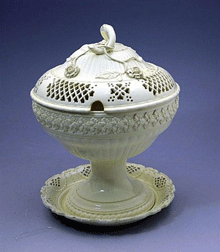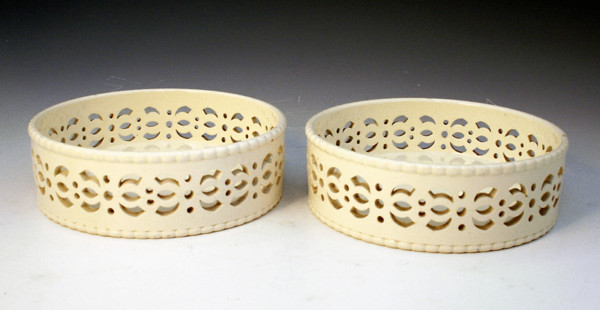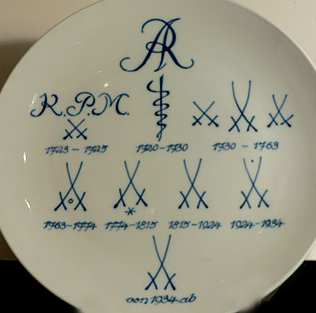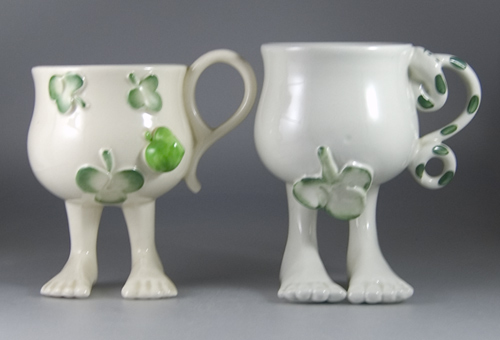Josiah Wedgwood the genius and innovative potter invented creamware in c1770. Wedgwood was influenced and worked with the other great potters of his time such as Thomas Whieldon and John Greatbach who were all based in the worlds hub of ceramics in Staffordshire.
 Josiah Wedgwood was a prolific inventor in numerous techniques associated with ceramics and the famous, and classic creamware body evolved from the development from Tin-glaze delftware, saltglaze and coloured glaze type wares which were in common use in the mid 18thc.
Josiah Wedgwood was a prolific inventor in numerous techniques associated with ceramics and the famous, and classic creamware body evolved from the development from Tin-glaze delftware, saltglaze and coloured glaze type wares which were in common use in the mid 18thc.
The full-scale introduction of creamware virtually finished the production of delft tin glaze and salt glaze in Great Britain.
The newly developed creamware body was very refined with a cream colour lead glaze which was very smooth.The glaze was so pure and fine that it needed no decoration to enhance its appearance or appeal. However, the glaze was so perfect that it also lent itself as a perfect ground base for hand painted decoration in overglaze enamels and transfer prints.
Josiah Wedgood was also a skilled marketing man. His masterstroke was to give Queen Charlotte; Consort of King George 111 a gift of a creamware tea set in 1765 He cannily named his newly introduced body as “Queensware”. Wedgwood realised that any wares, which graced the table of the Royals, would establish his wares as the must haves of the day. The sales of his creamware (Queensware) went through the roof resulting from one of the best marketing ploys of all time.
The introduction of creamware sent a shockwave through the pottery industry and its popularity was further confirmed and enhanced when the Russian Empress Catherine 11 commissioned a full dinner and dessert service of creamware from Wedgwood.This set was known as the Husk service. Such was Empress Catherine’s delight with the wares that she commissioned a further set .The set comprised of 952 pieces decorated with 1244 hand painted separate views of Great Britain. The hand painted borders were a running oakleaf and acorn for the dinner service and ivy for the dessert, both broken for the insertion of the green enamel frog emblem that gave the service its name.
 The Frog service was produced in 1773-74. It was ready for delivery in June of 1774 but once again the marketing skill of Josiah came to the fore when he exhibited the stunning set at his London Greek Street showroom, admission by ticket only.
The Frog service was produced in 1773-74. It was ready for delivery in June of 1774 but once again the marketing skill of Josiah came to the fore when he exhibited the stunning set at his London Greek Street showroom, admission by ticket only.
The great and the good were invited and the success of the exhibition and the major commissions along with the Queen’s appointment made Wedgwood the premier seller of fine tableware in Europe.
Stemming from the success of the introduction of Creamware potters in Europe, and of course Britain, began to imitate Wedgwoods creation. The pottery business was very competitive in the late 18th century and several factories in Yorkshire, Derbyshire, and Swansea and of course Staffordshire competed with Wedgwood for the new market. The most serious contender was the Leeds Pottery in Yorkshire.
The Leeds pottery was so successful that today “creamware” is often referred to as “Leeds ware”. It was a neck and neck race between these two factories. The match could be considered a draw as both potteries dominated the market at the end of the 18thc.
The finess of the body used for creamware enabled very fine detailed modelling and moulding of pieces. Many of the items produced were copies of silver ware and some pieces were heavily influenced by the Adams which was at the height of fashion in the late 18thc century. The classical look of these items is a constant reminder that good design never goes out of fashion. Examination of these exquisitely modelled pieces from the late 18thc reveal a constant beauty of form and line which has not been surpassed to this day.
The Leeds pottery were famous for their reticulated pierced work and their catalogue is packed with items ranging from basic tableware’s through to really elaborate centre pices, cornucopia covered dishes, cockle pots, candlesticks etc.etc.The range of products made by the 18thc potters is staggering.
The Churchyard Works where Josiah Wedgwood served his apprenticeship
The small pottery site occupied and worked by the Wedgwood family from 1656, when Josiah Wedgwood I’s great-grandfather first took possession of it.
Josiah served his apprenticeship there. The site derives its name from the nearby Church of St John’s, where Wedgwood himself was baptised on 12th July 1730.












